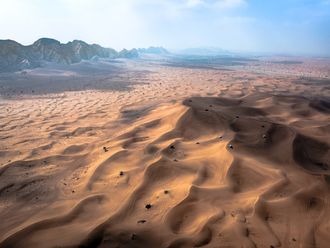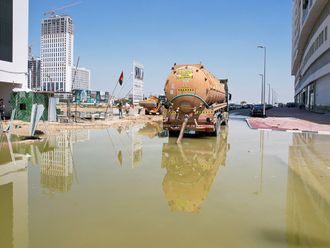
Dubai : Dubai's most famous whale shark checked out of her five-star home on Thursday, March 18 at 5.15am.
Her departure marked the end of a controversial 18-month stay and was filmed, said a top marine scientist at Atlantis.
Following criticism that no visual proof of the release has been presented - leading to wild speculation the shark fell ill and died in captivity - Steve Kaiser, Vice-President, Marine Sciences, said the private release exercise was filmed, but the public and media were excluded for the shark's safety.
Under cover of darkness, the 4.5-metre shark was released on the eastern end of The Palm crescent along the sea wall boulders, XPRESS has confirmed through multiple sources.
The clandestine nature of the pre-dawn operation ensured waters were free of boats and dangerous propellers to give the shark clear passage out to sea, he said.
The release is important, given that whale sharks, the largest fish in the world, are listed as vulnerable and easily targeted for their fins, which can fetch small fortunes in fish markets. Grey and covered with white spots along bodies that can reach up to 12 metres, these sharks are easy prey because they move slowly and are often found near the surface.
Irrefutable evidence
"We have photos and video," Kaiser said in an exclusive interview, "but I don't release photos, I release animals."
Kaiser has worked at the sister Atlantis hotel in the Bahamas where he helped in the release of other marine creatures such as large manta rays into the wild.
The decision whether to issue photos by Atlantis is in the hands of higher-ups at the $1.5 billion (Dh5.51 billion) Atlantis hotel and is not his to make, he said. An official media request through Kaiser to Atlantis executives for photographs or video went unanswered by press time.
Kaiser said the operation was top secret from the beginning, given months of bad press, public concern about the animal's continued captivity and fears that rubberneckers would swamp the hotel area and possibly compromise the effort.
"We didn't make this a media event. If we announced this, we would have 50 boats offshore," Kaiser said, adding hundreds of curious onlookers could have also gathered on shore. "It could go off the rails. We put our animals first."
Kaiser said an elaborate operation involved two large cranes, the first to lift the shark out of the hotel's 45-million litre aquarium facilities and place it on a truck for transport to the second crane tasked to lower the whale into the Gulf along the sea wall.
According to Kaiser, the operation was carried out in darkness and cooler temperatures to reduce stress on the animal. In the five days leading up to the top-secret operation, the aquarium temperature was raised from its usual 23C closer towards the 35C Gulf water temperature to help the whale adjust to natural waters when released, he said.
"We didn't want her to go into thermal shock," said Kaiser, an American who has worked in the marine field since 1974.
Kaiser's account of the Dubai release was corroborated by Al Faris Equipment Rental senior officials who confirmed that the shark was freed some time after 5am on March 18.
As per plan
Al Faris Operations Manager Charles Govias said "all went as planned" after crane operators and Atlantis staff conducted a "dry run first" a few hours before the real operation was carried out.
Al Faris' Technical Manager Brian Green said they prepped two Liebherr cranes - a 500 tonne one and a 1,200 tonne one - the day before to get a fresh start right after midnight.
Green said when the shark was lowered into Gulf waters "it was still dark and we had spotlights on her". A team of eight divers waited in the water to help free the shark from her plastic container. "They undid one end and she swam out peacefully and off she went," Green said, noting that not a single detail was overlooked to keep the shark safe at all times during transport. "This was planned for months and months. It was an operation straight out of James Bond."
Green said freeing the shark privately proved a wise choice.
"This way it was less likely to draw people and end up like the end of a circus," he said.
After a year of brickbats being thrown at Atlantis for not releasing the creature sooner, Kaiser defended the decision noting that it was set for release a year ago during the migratory transit season for the species in the region. Those plans, however, were dashed amid the red tide bloom here in early 2009 which lessened the shark's chances of a solid return to the deeps.
"It would be completely irresponsible to release her in the middle of the red tide," said Kaiser, who waited for the migratory season to roll around once more before her release. The bad timing led to a string of less-than-favourable media reports throughout last year that Atlantis was planning on keeping the shark as a tourist attraction, he said.
The irony is that even after Atlantis announced her release, people remain ever sceptical.
"Lots of people said we would never release her. Now they say we didn't release her," Kaiser said.
Recovery time
Contrary to reports that wide-roaming sharks don't do well in captivity, he said the whale shark recovered well from the time her listless frame was found by rescuers in August 2008 off Jebel Ali. The shark was discovered in 39C water, with higher-than-normal salinity levels and was suffering from what Kaiser called a serious "heat stroke" before she was taken back to the $3 million (Dh11 million) marine rescue centre at Atlantis for recovery.
Estimated at 1.5 tonnes and between the age of 6-8 years, the shark measured 3.8 metres long when first rescued, Kaiser said, but when released it had grown by 60 centimetres.
As she slipped out of her custom cradle into the sea late last week, the shark was fitted with a tracking tag to monitor her movements for 90 days. In partnership with shark research organisation Mote Marine Laboratory in Florida, Kaiser and staff have pre-set the electronic tag to detach itself from the shark and float to the surface where the device will transmit its data to satellite.
"We have made Mote Marine the recipient of that data," he said, noting the information may help marine scientists better understand the whale shark for future conservationist efforts.
The cloak-and-dagger-style release of the Atlantis whale shark is in stark contrast to other Atlantis releases of sea creatures into the wild, according to media reports.
In early 2008, for example, American network giant NBC featured on its Today Show the release of a large manta ray from Atlantis, Paradise Island resort, Bahamas.
After living at the Atlantis aquariums for roughly three years, the giant relative of the shark was shown being tagged with a satellite tag to track its movements in the Caribbean seas.
The manta ray was put in a large sling and flown by helicopter to its release location and then released into waters offshore.
Rescue was in the bag...
If you've ever tried to scoop a goldfish out of a home-variety fish tank, you can appreciate the difficulty Atlantis faced in scooping a 1.5 tonne shark out of a behemoth indoor aquarium.
Those who watched the lift-out were amazed when a team of divers plunged into the waters and manoeuvred a six-metre-long plastic bag of sorts into place directly in front of the slowly-swimming whale shark.
"She swam herself right into the bag on the first attempt," said one of those watching the spectacle. "The divers were fantastic, they just guided her right in."
Divers then moved to close the bag and, with a thumbs-up, the water-filled bag was lifted up and out of the tank, over part of the Atlantis hotel rooftop and onto a waiting support frame on a truck waiting in the car park nearby.
Divers simply repeated their aquarium efforts in reverse when the shark was released into the Gulf waters.













